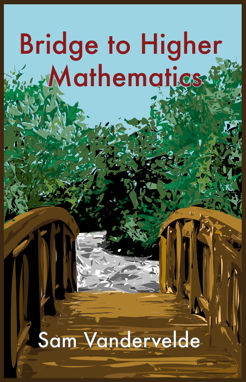
|
Bridge To Higher
Mathematics,
by Sam Vandervelde
..
|
This textbook is designed to equip students
who have completed a standard high school math
curriculum with the tools and techniques that
they will need to succeed in upper level math
courses. Topics covered include logic and set
theory, proof techniques, number theory,
counting, induction, relations, functions, and
cardinality.
A significant portion of the book is
available for download, in order to review the
book or learn material. Click on the links
below to obtain the desired sections of the
text.
Bridge to Higher Mathematics is
available at www.lulu.com and also at
amazon.com. The list price is $32 at either
site; the book itself is published through and
printed by lulu.com.
|
|
 |
|
All known errors were corrected in May
2013, at which point small changes were also made to
the wording in several places, one paragraph involving
Fibonacci numbers was rewritten to implement a better
technique, and two exercises changed to reflect this
new approach. However, in all other respects the
current version of the second edition is identical to
the original and can be used in its place without any
difficulty. As always, please do not hesitate to
contact the author if you
believe that you have found an error in the text.
The following excerpt is taken from the
back cover of the book.
The text incorporates unique features such as
Concept Checks and Mathematical Outings to actively
engage the reader in the development of new ideas.
The author, who writes questions for the USA Math
Olympiad, has composed hundreds of thought-provoking
problems to complement the lively exposition. Each
chapter concludes with a reference section that
concisely summarizes the definitions and proof
strategies introduced in that chapter. Finally,
answers to all the exercises and hints to every
writing problem are included in the final chapter.
..
Errata Page for Bridge to
Higher Mathematics
(current edition)
- In an attempt to "improve" Problem 1.10 it was
rendered impossible. (Alas.) The
question should ask for the fourth and thirteenth
student, not the third and fourteenth.
..
Errata Page for Bridge to
Higher Mathematics
(for copies obtained prior to June 2013)
- The abbreviation EOR for “exclusive or” used in
Chapter One is not standard. The more commonly
employed abbreviation is XOR.
- The answer to Problem 1.41 should refer to eight
people rather than ten, of course.
- The answer to Problem 1.50a on page 208 should read
"If 3^k+1 is
a multiple of 4 then k is odd." Furthermore, the
answer to 1.50c is "If a is positive then 2^x=a has a
solution." How do these mistakes creep in so
relentlessly, I wonder.
- To avoid dealing with degenerate triangles, problem
1.71 would be better stated as "Explain why given any
finite collection of three or more points in the
plane, no three of which are collinear, there exists a
triangle..."
- The answer for Exercise 2.9b should read { 2^(n-1) + 1
| n in
N }, or
perhaps more naturally as { 2^n + 1 | n in Z, n≥0 }.
Alternatively, change the set appearing in the problem
to be just {3, 5, 9, 17, 33, 65, ... }.
- The answer for Exercise 2.10 should specify that m≥1,
k≥0.
- Exercise 2.41 should read: If C={s, a, t, i, n} then how many
sets D
satisfy... (The word `many' was omitted.)
- Exercise 3.1h on page 57 is better stated as “... A is not a
subset of B.”
- The answer to Exercise 3.8a on page 213 should
involve the cubes of m and n as opposed to their squares, while
answer 3.8b should have x≤1.
- The list of divisors of 24 in the answer to Exercise
4.2 on page 216 inadvertently leaves off 8 and
-8. (I used to know my divisors of 24...)
- Alas, the assertion in Exercise 4.13 is true; just
take a =
1. The statement should read “distinct positive
integers a,b>1.”
- The answer to Exercise 4.58 on page 219 should read
{-(k–1), -(k–2), ..., k–1, k}. (It
would also be fine to list the numbers from -k to k–1.)
- On page 99 in Section 4.5 the Quick Query b) answer
should state "0+0+1=1," not "0+1+1=1." Ay,
caramba!
- The answer to Exercise 4.86 on page 220 makes no
sense because we updated this problem but neglected to
also update the answer. The actual conjecture is
that every odd number above 10 can be obtained in this
manner except for 15. (Note that the primes used
must be distinct, so 15=5+2(5) doesn't work.)
- There is a typo in the answer to Exercise 4.88 on
page 220; the counterexample is 232+1.
- Problem 5.13 on page 113 should have specified
distinct nonzero
digits.
- Problem 5.63 on page 127 refers to a Mathematical
Outing from Section 5.1, when in actuality it was from
Section 5.3. Oops.
- The hint for Problem 6.35 on page 226 is inadequate
since it only applies when r and s are positive rationals. A
better approach would be to suppose that r/s=a and s/r=b for natural
numbers a
and b.
Then multiply these equalities to get ab=1, which
forces a=b=1,
hence r=s.
- The statement of Writing Problem 7.9 on page 174
should read “if and only if ”. (The second
“if ” was accidentally omitted.)
- The answer to Exercise 7.3 should read f(n)=3/4(n–1). (The
formula for g(n) is fine.)
- The answer for Exercise 7.34 should refer to the
point (3,0), rather than (3.0). (Replace the
decimal point with a comma.)
- Sample Proof 7.1 on page 201 should use g(x) in the
displayed equation rather than f(x).
- The answer to Concept Check d) on page 195
inexplicably claims that ln 3 maps to 1/4. In
fact, ln 3 maps to 3/4, which has binary
representation .110000..., leading to the correct
answer of {1,2}.
|

